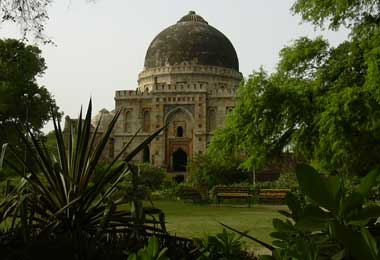Off Duty: Delhi
As India celebrates the 60th anniversary of independence, Harriet O’Brien takes a tour of the city that the British made the country’s capital

Why?
Delhi's brash veneer can be daunting. But beyond the immediate barrage of unscrupulous touts and madcap drivers is an absorbing city offering an intriguing juxtaposition of Moghul India and Imperial Britain at its most grandiloquent.
Old Delhi is a maze of alleys and organised chaos. It developed as the 17th-century walled city of Shahjahanabad and today it extends into the Civil Lines further north, which is where the British took up residence until they built New Delhi. When the colonial rulers decided to move India's capital from Calcutta they designed a new city south of Old Delhi. Officially inaugurated in 1931, New Delhi was built to an orderly plan of wide, tree-lined avenues and splendid parliamentary buildings.
New Delhi is the business hub of northern Indian – and offers much of the city's accommodation. The 17-storey Shangri-La Delhi at 19 Ashoka Road, Connaught Place (00 91 11 4119 1919; www.shangri-la.com) opened at the tail end of 2005, a glittering and welcome addition to a city short on quality hotels. The 320 rooms are styled "contemporary Asia" (silk cushions, discreet lighting, flatscreen TVs) and most offer truly great views. For sheer style – and one of the best swimming pools in town – check into the Taj Mahal Hotel at 1 Mansingh Road (00 91 11 2302 6162; www.tajhotels.com). The corridors of this landmark building are peppered with artworks, while its fountain-filled lobby and the Emperor's Lounge beyond are where Delhi's fashionable set meets.
What
Old Delhi presents a challenge to the senses and a rewarding culture shock. Start a trip here by taking a look at the great Moghul remains of the Red Fort (run by the Archaeological Survey of India (www.asi.nic.in) on the eastern edge of the old city. The fort was built between 1638 and 1648 by emperor Shah Jahan, who was simultaneously constructing the Taj Mahal in Agra in memory of his wife. It opens 6am-sunset daily except Mondays. Then negotiate your way along the pandemonium that is Chandni Chowk. Old Delhi's main street is invariably congested with rickshaws, shoppers, goats, cows and more. Stop (removing your shoes and all leather) at the 16th-century Digambara Jain Temple, where, remarkably in the midst of all the surrounding chaos, the Jains run a hospital for sick birds.
Then, for an almost crazy contrast, take a taxi into the British Imperial city. Head for India Gate, a stately memorial for the First World War. From there, gaze up Rajpath (Kingsway) to Rashtrapati Bhawan, the president's residence, which is flanked by the Secretariat offices. These magnificent buildings were the work of Lutyens and Sir Herbert Baker, who incorporated Moghul-style domes and filigree work into their Classical designs.
In the late afternoon, join the locals by taking a stroll. Make for Lodi Gardens, south of India Gate, a sublimely peaceful space landscaped around 15th-century tombs and filled with green parakeets, hoopoes and mynah birds.
For retail therapy most visitors head for Dilli Haat on Sri Aurobindo Marg (www.dillihaat.org). Modelled on a traditional village market, this large, open-air collection of artists' and craftsmen's stalls sells handicrafts from across India.
For a real Delhi institution, though, make for the Central Cottage Industries Emporium, at Jawahar Vyapar Bhawan, Janpath (www.cottageemporiumindia.com), where you can buy anything from pashmina shawls to miniature paintings. Across the road is Janpath market, where you can haggle with street vendors over cotton shirts, beautifully inlaid chess sets and leather goods (you'll find the best deals for the latter in the underground Palika Bazaar at the north end of Janpath).
Where
To get the vibe of modern Delhi join the crowd at the uber-chic bar of The Park Hotel at 15 Parliament Street (00 91 11 2374 3000; www.theparkhotels.com). Then step back in time: for classic Moghul-style cuisine head to Karim Restaurant (00 91 11 2326 4981; www.karimhoteldelhi.com) near Old Delhi's great mosque at 16 Jami Masjid. From the outside it looks underwhelming, but you may have to queue to get at table at this Delhi favourite which opened back in 1913.
In New Delhi, the gracious colonnaded Imperial Hotel on Janpath is home to the renowned Spice Route (00 91 11 2334 1234; www.theimperialindia.com), a pan-Asian restaurant serving dishes from Kerala to Vietnam. Its striking décor includes Thai pagoda roofs and Nepalese carvings.
In west Delhi, Bukhara, at The Maurya hotel, at Diplomatic Enclave, Sadar Patel Marg (00 91 11 26112233; www.starwoodhotels.com), is arguably the best restaurant in the city, its speciality being northwest frontier cuisine – the likes of tandoori lamb raan served from a traditional clay oven. Or head for the rooftop where The Maurya has just opened a new restaurant, My Humble House, offering contemporary Chinese dishes.
Meanwhile, for seafood, head south to Delhi's Defence Colony area where Swagath at 14 Defence Colony Market (00 91 11 2433 7538; www.swagath.in) serves spicy lobster, crab and more.
Wow
Humayun's Tomb on Mathura Road (www.asi.nic.in), open daily 6am-sunset, is Delhi's most entrancing monument. Humayun was the second Moghul emperor and his mausoleum was built in the 1560s by his senior widow, Haji Begum. With its marble dome and fine inlay work, the design of this stunning red sandstone edifice became the blueprint for the Taj Mahal.
Subscribe to Independent Premium to bookmark this article
Want to bookmark your favourite articles and stories to read or reference later? Start your Independent Premium subscription today.

Join our commenting forum
Join thought-provoking conversations, follow other Independent readers and see their replies